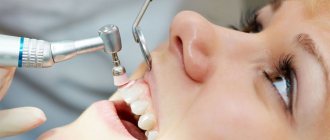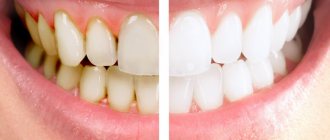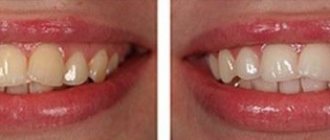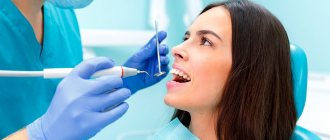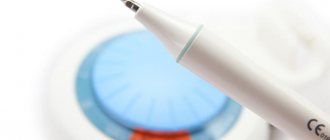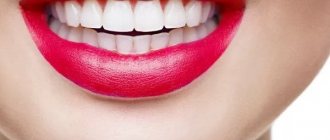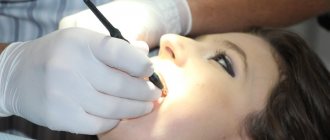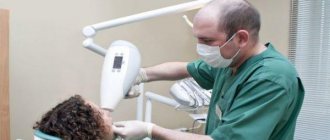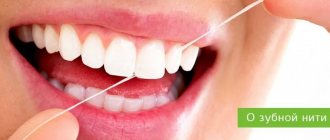Professional oral hygiene is comprehensive care aimed at preventing dental diseases. The technology allows you to get a “brilliant” result in one hour and achieve natural whiteness.
The procedure includes removing plaque using the Air Flow method and cleaning hard plaque with an ultrasonic scaler. At the final stage, fluoridation and remotherapy are performed to strengthen the enamel. In addition, the attending physician teaches the patient about home hygiene and selects care products. Professional care is highly effective, but maintaining the results is only possible if all the dentist’s instructions are followed.
Enamel sensitivity
May increase in the first days after professional hygiene. At first, to avoid pain, it is better not to consume sour or very sweet foods and drinks. It is not recommended to consume cold and hot at the same time or too cold, hot drinks and foods. This is dangerous not only by increasing the sensitivity of the enamel, but also by weakening it and the appearance of microcracks on its surface.
To prevent enamel sensitivity from increasing after professional cleaning, it is better to complete the procedure with remineralization or fluoridation. This will strengthen the enamel and remove discomfort.
If the enamel is weakened, after cleaning, the doctor may additionally prescribe special products, toothpastes, to strengthen it.
If severe pain persists after the procedure or the pain does not decrease within several days, you should consult a dentist.
Oral care after professional hygiene
Today you underwent a complex of professional oral hygiene.
Please read these instructions carefully. Following it will reduce discomfort and also reduce the likelihood of complications.
- It is not recommended to eat food within 2 hours: food containing coloring components, drinks (coffee, black, green tea, red wine), vegetables (beets, carrots), seasonings (soy sauce, curry mixture, turmeric), fruits (currants , blueberries, cherries, mulberries) are not recommended to be consumed within 12 hours.
- It is not recommended to consume foods that increase tooth sensitivity: - drinks (juices, carbonated drinks) - fruits (lemons, apples).
- Avoid smoking for 2-4 (preferably 12) hours. Don't forget that smoking is harmful to your health!
- Avoid rinsing for 2 hours. It is recommended to drink mineral water.
- After professional oral hygiene, a possible reaction of the body is the appearance of increased sensitivity of the teeth and slight bleeding of the gums. If necessary, you can use a rinse 2 times a day for 6-7 days (Chlorhexidine digluconate solution 0.05%, Miramistin, etc.) followed by application of gel to the gums and interdental spaces ("Metrogil denta", "Solcoseryl Dental adhesive paste" - two times a day for 7 days. To reduce sensitivity, you can use toothpastes labeled "sensitive" and Tousse Mousse gel containing calcium and phosphate. The gel must be applied to the teeth after brushing your teeth at night according to the instructions. Avoid taking hot and cold food during the day.If increased tooth sensitivity persists for a long time, contact your dentist.
- After professional teeth cleaning, you should not use alcohol-containing mouth rinses for the first 3-7 days.
- It is recommended to change your toothbrush.
- It must be remembered that daily brushing of teeth is one of the most important elements of a set of oral care measures, especially if you have implants, removable and fixed dentures, artificial crowns, restorations, veneers, splinting devices, and also if braces or retainers. It is food remains that are the main culprits in the formation of plaque, and therefore the development of caries and periodontal tissue diseases - periodontitis. You should brush your teeth in front of a mirror at least twice a day, and if possible after each meal, for at least 2-3 minutes (keep an hourglass in the bathroom, it will help you keep track of time), using special hygiene products:
- Toothbrushes (regular, electric, ultrasonic) with toothpastes;
- Oral irrigator;
- Floss (dental floss);
- brushes;
- Superflosses (in the presence of fixed dentures);
- Mouth rinses.
- Regular visits to the dentist to maintain treatment results, remove tartar or bacterial plaque, and check hygiene should be made every 6 months. Patients treated with orthodontic structures require professional hygiene every 3-6 months.
sign up for a consultation
Related services:
Additional care products
Dental floss, floss. Used to clean interdental spaces. After professional cleaning, use floss carefully so as not to injure the edges of the gums. Movements are directed from the gums to the cutting edge or to the chewing surface of the crown. Floss is used several times a day, as needed (after meals, after morning and evening brushing of teeth).
Irrigator. Using an irrigator helps to maintain the results of professional hygiene for a long time. The device cleans enamel with a thin stream of water under pressure. This type of cleaning removes soft plaque well and prevents the formation of tartar. The irrigator is used once a week or less. It is better if the frequency of such cleanings is determined by a doctor, taking into account the condition of the enamel.
After cleaning dentures
In cases where the patient already has orthopedic structures installed, professional teeth cleaning is recommended at intervals of 3-4 months.
This depends on how carefully, correctly and regularly individual hygiene is carried out in the presence of artificial crowns, bridges and other types of prostheses, which determines the degree of healthy condition of one’s own teeth in contact with existing orthopedic structures.
Particular attention should be paid to the areas of contact between the prosthesis and the gingival margin. The appearance of a defect in the contact area makes it difficult to clean it and contributes to the intensive accumulation of plaque and food debris under the denture.
How smoking affects teeth
Smoking is harmful to the entire body, including the teeth, which are the first to bear the brunt of tobacco smoke and high temperatures. Under the influence of cigarettes, the enamel begins to deteriorate, microcracks appear on it, through which tobacco smoke substances and bacteria present on the teeth quickly penetrate.
Plaque formation in smokers occurs quickly, and it is difficult to remove it on your own. In addition, tobacco lovers are unlikely to brush their teeth after every cigarette they smoke. As a result, the enamel is destroyed, which leads to tooth decay, and the plaque gradually hardens, forming tartar, which contributes to the development of gum disease.
The longer a person smokes, the more their teeth will suffer. Gradually, negative processes will begin to progress, which will undoubtedly entail serious aesthetic and pathological consequences.
How do you know when it’s time to change crowns?
Cracks, poor fixation on the tooth, discoloration, discomfort when closing the jaws - all these are reasons to consult a doctor. A crown can fail either after 2-3 years or after 10-15 years - a lot depends on the initial situation, the professionalism of the doctor, the quality of the material, as well as on how the teeth were used. We strongly recommend visiting the dentist 1-2 times a year to examine the oral cavity - the doctor will be able to assess the quality of fixation of the prosthesis and its integrity. This way, you won’t have to guess how long the crowns will last, but will be able to understand exactly when you need to worry about replacing them.
All recommendations boil down to the fact that crowns, inlays and bridges, like living teeth, require regular care and careful treatment. Do not forget that in addition to artificial crowns, living tissues remain in the oral cavity - these are gums and ligaments that hold the root of the tooth. All of them are susceptible to inflammatory processes, which can lead to the loss of the remaining living tooth along with the installed prosthesis.
Temperature rises after tooth extraction
A slight increase in general body temperature or local temperature in the area of the operation is considered normal. This is the body's natural reaction to dental surgery.
If the temperature stays within 37-38° C, there is no need to bring it down. If it rises above 38° C, you need to take antipyretic drugs. Avoid using aspirin as it may cause bleeding from the socket.
An increase in temperature over a long period (2 or more days in a row), accompanied by signs of inflammation - severe pain, swelling, swelling of soft tissues, an unpleasant odor from the wound, are direct indications for urgent medical attention.
List of prohibited products
In the first two weeks, you need to treat your teeth especially carefully. Hot and cold food is prohibited; everything should be moderately warm. There is no need to expose the enamel to even mild acid, so you will have to exclude fermented milk products.
With a white diet, you eat everything that is light in color. Animal products include:
- white meat and fish,
- egg white,
- soft cheese (mild and without spices),
- fresh milk,
- butter.
The following herbal products are acceptable:
- rice,
- pearl barley,
- cereals,
- white beans,
- potato,
- pasta,
- flour products (only without sugar and coloring ingredients),
- light mushrooms (champignons or porcini),
- light vegetable oil,
- white sweet pepper,
- peeled cucumbers,
- bananas,
- white and clear drinks (non-alcoholic).
The remaining vegetables and fruits are divided into two groups: unacceptable and conditionally acceptable. For example, beets or carrots are prohibited in any form. Conditionally acceptable include those for which heat treatment is sufficient to destroy the acid and weak pigment. For example, boiled cabbage or sour baked apples without peel.
Do not use:
- dairy products;
- egg yolk;
- red fish;
- red meat;
- sausage and ham (contains dyes);
- light fruits (if they are sour and have peel);
- colored fruits and vegetables;
- greenery;
- unpeeled cucumbers;
- sweets;
- spices, sauces, vinegar;
- colored drinks (including coffee, black and even green tea);
- alcohol.
- In the first four days after bleaching, you must strictly follow the rules. From the 5th day you can allow yourself relaxations, but small ones. For example, drink green tea through a straw or fermented baked milk, then immediately brush your teeth or rinse your mouth.
It is advisable to adhere to a white diet for a month, the minimum required period is 14 days. At this time, it is not yet recommended to paint your lips, since accidentally getting gloss or lipstick on the enamel is equivalent to using a coloring product.
Professional whitening
Many smokers resort to home whitening methods. However, even specialized means for lightening tooth enamel are not able to rid tooth enamel of ingrained dye.
Professional whitening, thanks to specially developed technology, helps make tooth enamel lighter by 3, 5 and even 10 shades, depending on the technique used.
The most effective methods are:
- air flow;
- Zoom;
- laser;
- ultraviolet.
As a rule, smokers need several procedures to completely remove the dyes that have become embedded in their teeth. The effect may exceed all expectations.
What to do after a child’s tooth extraction
After removing a child’s baby or molar teeth, parents should closely monitor the baby’s condition and well-being.
It is necessary to ensure that the child follows the following rules:
- Do not rinse your mouth or spit, as this may cause the blood clot to be removed from the socket;
- Did not engage in vigorous physical exercise and did not overheat;
- Brush your teeth efficiently and responsibly, avoiding the injured area with a brush;
- Take the necessary medications in full and according to the schedule established by the doctor;
- Carefully and promptly made baths with antiseptic or medicinal products;
- He did not put any foreign objects in his mouth and did not touch the socket with his fingers or tongue.
The child’s body temperature, swelling of soft tissues and the child’s breath must be monitored. In case of complications, consult a doctor immediately.
What to do after tooth root removal
Root removal is often accompanied by circumstances that complicate the dentist’s work and can negatively affect the duration and course of the recovery period.
In order for rehabilitation to progress at a normal pace and tooth reconstruction to begin, the patient must follow the rules of the recovery period.
First of all, it is necessary to avoid the occurrence of inflammation in the area of the torn root. For this you will need:
- Observe the rules of personal hygiene;
- Do not overheat the head area;
- Do not rinse or touch the affected area with your tongue;
- Do medicinal baths, take painkillers, start taking antibiotics if the doctor gives such a recommendation.
You should try to protect the area of the torn root as much as possible, since any infectious process at the site of removal can lead to serious complications.
Clinical researches
An analysis of the clinical effectiveness of the use of various therapeutic and prophylactic agents of the Asepta series, carried out in Novosibirsk, at the State Budgetary Educational Institution of Higher Professional Education "Novosibirsk State University", confirmed that the line is different:
- Pronounced hygienic;
- Anti-inflammatory;
- Hemostatic property.
The study examined the effect of the products on the oral health of adolescents, patients with the most sensitive tissues and with pain in wisdom teeth. The use of pastes, balm with propolis and rinse demonstrated an improvement in clinical indicators and confirmed high efficiency in the treatment of periodontal pathology in patients of different ages.
What not to eat after teeth whitening
Darkening, pigmentation, and the appearance of spots are promoted by 3 factors: chromogens (substances that acquire color during oxidation), acids and tannins (tannins). They are found in many foods and can stain teeth, cause an unpleasant reaction, and even destroy enamel.
Products containing acids
- Citrus fruits e
. Even sweet tangerines contain a large amount of acid, which corrodes the protective layer. - Tomatoes
. They are not only red, but also sour. - Carbonated drinks
. They are carbonated with carbon monoxide, so even colorless carbonation is the enemy of enamel. - Fruit juices
. In terms of the amount of acids, they are comparable to carbonated drinks. - Pickles and marinades
. Vinegar is a strong acid that aggressively destroys surface layers.
Products containing acids
Products containing pigments
- Tea
(green and black),
coffee
. The tannins contained in these drinks have a cumulative effect. One cup may not stain your teeth, but there are no guarantees about the fifth. - Wine
. And white wine too. Red wine has a lot of coloring pigments, but any wine has acids. - Sweet carbonated drinks
are also included in this group. Most of them contain acids that destroy enamel, as well as pigments that leave stains on it. - Dark fruits and berries
. The combination of acids and pigments can ruin the whitening result. All red, blue, purple berries and fruits should go into oblivion for 2 weeks. - Chocolate
and colored candies. Sugar and pigments are a bad combination for tooth enamel. - Sauces
. Avoid soy sauce, balsamic vinegar, ketchup. Or better yet, any sauce at all. Most contain acids, tannins, pigments, or all three.
Products containing coloring pigments
It is better to heat-treat products that raise doubts.
After ultrasonic teeth cleaning, you should not...
If you compare preventive teeth cleaning with ultrasound in the dentist’s office with other methods of professional teeth cleaning, for example, chemical or mechanical, then the advantages of this method become obvious. Firstly, there are much fewer contraindications and restrictions for ultrasonic cleaning (the use of the technique is not prohibited even for pregnant women), and secondly, dental treatment using ultrasound is absolutely safe and painless. Thirdly, during the procedure it is possible to achieve the effect of whitening the tooth enamel by several tones and, finally, after ultrasonic teeth cleaning only patients with increased tooth sensitivity will not be able to immediately return to their usual diet and lifestyle.
However, in order for the results of professional teeth cleaning with ultrasound to remain unchanged for a long time, and also to avoid minor discomfort while eating in the first 2-3 days after the procedure, it is recommended to follow a few simple rules.
Learn more about the benefits of teeth whitening and teeth cleaning
Why does tartar appear?
There are many reasons for the deposition of hard plaque, including:
- poor teeth cleaning at home;
- incorrectly selected brush and paste of inadequate quality;
- smoking;
- a large amount of soft food in the diet that does not require thorough chewing;
- dysfunction of the thyroid gland;
- uneven teeth and chewing food on only one side of the jaw.
Removing tartar is much more difficult, and it brings much more problems. In order to avoid possible complications in the future, professional teeth cleaning in dental offices by hygienists will help.
Can I use dental floss?
If you have any dentures in your mouth, you should either refuse floss completely or use it too carefully. The crowns are fixed in such a way that natural micro-gaps between them are preserved, which require cleansing. However, when flossing, you should not make vertical movements - only horizontal ones. That is, you need to insert the thread not from the cutting edge, gradually moving towards the gums, but place its tip directly into the gap - make several horizontal movements and remove it in a similar way.
Do not use the prosthesis if it has a chip or crack - try to see a doctor as soon as possible to restore the integrity of the crown/inlay or for a prompt replacement. Otherwise, there is a high risk of developing inflammatory processes under the prosthesis.
How much can you eat after dentures?
After installing permanent crowns or inlays, you can drink water immediately, but eat after 1.5-2 hours. This is not related to the type of prosthesis or the adhesive used for fixation. During treatment, anesthesia is used - and it is very important that its effect wears off completely, otherwise chewing can injure the tongue or the inside of the cheeks.
After installing temporary crowns or inlays, you are allowed to eat food after 2-3 hours. However, in such a situation, it is strongly recommended not to put any stress on the restored tooth and try to chew food on the other side - not only at first, but throughout the entire period of wearing the temporary structure. It is impossible to put a load on such prostheses - they are not designed for it (naturally, if we are talking about crowns or inlays, which are installed for a maximum of 2-3 weeks, and not for a long time).
What to do after tooth extraction
After the dentist has completed all removal procedures, the patient must take the following measures:
- The tampon that the doctor placed on the hole must be removed no later than half an hour later. If the patient has poor blood clotting, you can keep the compression pad on for 60 minutes;
- To reduce the likelihood of swelling of the soft tissues of the mouth or face, it is advisable to apply something cold to the cheek. This treatment measure will be effective only in the first hours after surgery. A piece of ice or frozen meat wrapped in cloth should be applied to the cheek several times for 5 minutes;
- On the first day, to avoid inflammation, you can do antiseptic baths;
- It is necessary to gently, carefully, but carefully carry out all hygiene procedures in the oral cavity, not excluding the area where the tooth was pulled out.
Compliance with these rules after removal will promote rapid healing of the hole and prevent infection.
What foods are not advisable to eat?
Particular attention is paid to the list of what patients should not eat after teeth whitening. Limitations are associated with increased tooth sensitivity and the risk of enamel staining.
During the white diet, the following are excluded from the diet:
- any tea, except white;
- coffee drinks and cocoa;
- brightly colored sauces;
- drinks made from vegetables or fruits;
- fruits and berries with rich color;
- all citrus fruits and sour berries;
- dragees, lollipops, chocolate, jam;
- egg yolk.
Dentists also advise you to independently monitor the consumption of products containing dyes. To do this, you can even study the composition of the product on the packaging before purchasing it.
